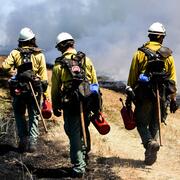Ecosystems We Research
USGS conducts research on public lands to deliver information used by resource managers to maximize and sustain economic and social benefits from natural resources to the American public.
Explore the Ecosystems We Research

From the coasts to the Arctic, the Nation’s ecosystems are complex, dynamic, and exposed to a rapidly changing climate among other threats. USGS scientists study how ecosystems function, the impacts of stressors, and make predictions about their future to improve restoration and management outcomes.













